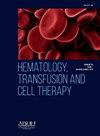CHIC2 DELETION-ASSOCIATED HYPEREOSINOPHILIA AND SUBSEQUENT JAK2 V617F POSITIVE THROMBOCYTOSIS
IF 1.6
Q3 HEMATOLOGY
引用次数: 0
Abstract
Background and aim
Myeloid/lymphoid neoplasms with eosinophilia and tyrosine kinase gene fusions (MLN-TK) are myeloid or lymphoid neoplasms driven by rearrangements involving genes encoding specific tyrosine kinases. These BCR::ABL1-negative diseases have long been recognized for their sensitivity to tyrosine kinase inhibitors. Herein, we present an interesting case diagnosed as myeloid neoplasm with abnormality of PDGFRA.
Case presentation
A 63-year-old female patient with known glaucoma, hypothyroidism, and vitiligo was admitted to our clinic 8-years ago with fatigue. The patient had splenomegaly and eosinophil-predominant (10 × 109/L) leukocytosis (70.8 × 109/L). Secondary causes of eosinophilia (rheumatologic, infectious and immunologic) were excluded. Although not directly attributed to the patient's hypereosinophilia, echocardiographic left ventricular contraction abnormality was observed. Bone marrow aspiration and biopsy were hypercellular and showed 35%‒40% eosinophils. With a preliminary diagnosis of hypereosinophilic syndrome, the patient was treated with steroids and then with hydroxyurea. Karyotype analysis was normal and FISH for t(9;22) was negative. The FISH panel revealed a 76% CHIC2 (4q12) deletion, but was negative for abnormalities of PDGFRB, FGFR1, and FIP1L1::PDGFRA fusion. The patient was switched to imatinib treatment. While the patient was followed in hematological remission for a long time with imatinib, thrombocytosis (807 × 109/L) was detected in the patient six months ago. The patient had suppressed erythropoietin level (1.94 mu/mL) and JAK2 V617F mutation. Low-dose hydroxyurea was combined with imatinib. Hematological remission was regained.
Discussion
The majority of MLN-TK cases associated with PDGFRA rearrangements have cytogenetically cryptic deletion of 4q12 resulting in FIP1L1::PDGFRA. Although FIP1L1::PDGFRA fusion could not be demonstrated in this patient, it was thought that the patient had a myeloid neoplasm with abnormality of PDGFRA class due to CHIC2 deletion and typical clinical findings. The fact that the patient responded to treatment for many years seems to be evidence of this. The detection of JAK2 mutation during follow-up raised the question of whether this clone was present in the patient from the beginning or was acquired later.
Chic2缺失相关嗜酸性粒细胞增多症和随后的jak2 v617f阳性血小板增多症
背景和目的嗜酸性粒细胞增多和酪氨酸激酶基因融合(MLN-TK)的髓样/淋巴样肿瘤是由编码特定酪氨酸激酶的基因重排驱动的髓样或淋巴样肿瘤。这些BCR:: abl1阴性的疾病长期以来被认为对酪氨酸激酶抑制剂敏感。在此,我们报告一个有趣的病例,诊断为髓系肿瘤伴PDGFRA异常。一例63岁女性青光眼、甲状腺功能减退、白癜风患者8年前因疲劳入院。患者脾肿大,嗜酸性粒细胞为主(10 × 109/L),白细胞增多(70.8 × 109/L)。排除了嗜酸性粒细胞增多的继发原因(风湿病、感染和免疫)。虽然不能直接归因于患者嗜酸性细胞增多症,但超声心动图显示左心室收缩异常。骨髓穿刺和活组织检查显示细胞增多,35%-40%嗜酸性粒细胞。初步诊断为嗜酸性粒细胞增多综合征,患者先用类固醇治疗,然后用羟基脲治疗。核型分析正常,FISH t(9;22)为阴性。FISH小组显示76%的CHIC2 (4q12)缺失,但PDGFRB、FGFR1和FIP1L1::PDGFRA融合异常呈阴性。患者转为伊马替尼治疗。在伊马替尼长期随访患者血液学缓解期间,6个月前检测到血小板增多(807 × 109/L)。患者红细胞生成素水平下降(1.94 mu/mL), JAK2 V617F突变。小剂量羟基脲联合伊马替尼。血液学恢复缓解。大多数与PDGFRA重排相关的MLN-TK病例存在4q12的细胞遗传学隐性缺失,导致FIP1L1::PDGFRA。虽然在该患者中无法证实FIP1L1::PDGFRA融合,但由于CHIC2缺失和典型的临床表现,我们认为该患者为PDGFRA类异常的髓系肿瘤。病人多年来对治疗的反应似乎就是证据。在随访期间检测到JAK2突变提出了一个问题,即该克隆是否从一开始就存在于患者体内,还是后来获得的。
本文章由计算机程序翻译,如有差异,请以英文原文为准。
求助全文
约1分钟内获得全文
求助全文
来源期刊

Hematology, Transfusion and Cell Therapy
Multiple-
CiteScore
2.40
自引率
4.80%
发文量
1419
审稿时长
30 weeks
 求助内容:
求助内容: 应助结果提醒方式:
应助结果提醒方式:


